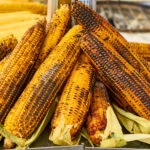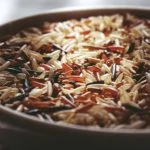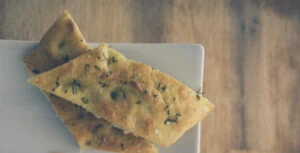Learn how to roast chestnuts for a festive and comforting snack with just one ingredient and your oven. This is all you need to know to turn whole raw chestnuts into a delicious snack.
How do you roast chestnuts? Wash the chestnuts, dry them, mark them with a knife, place them on a baking sheet, roast them at 425°F for 20 minutes, peel them, and enjoy!
This recipe is incredibly quick, easy, and delicious!
What are chestnuts?
There are several different varieties of nuts called chestnuts. These large brown nuts are native to North America, Europe, and northern Asia. They thrive in chilly climates and grow on trees with the same name. The edible variety of chestnuts grow inside large prickly seed pods. These pods are discarded before the chestnuts make their way to supermarket shelves.
While chestnuts are rarely eaten raw because of their hard texture and bitter flavor, cooked chestnuts have a deeply satisfying, creamy, and almost cake-like texture. Their flavor is warming and a bit sweet, like vanilla or cinnamon. These nuts are often seasoned with similar warming spices.
Is it better to boil or roast chestnuts?
There are a few good ways to cook chestnuts. The most common are boiling and roasting them. And both a good options. However, boiling chestnuts does not produce the same smoky, toasted flavor and slightly crisp texture on the outside of the nuts. Instead, the chestnuts are very soft and moist. If that’s what you prefer, however, by all means, boil your chestnuts instead of roasting them.
Roasting chestnuts is the preferred method for most people. This is because roasting dries the nuts out a bit, which concentrates their flavor. As a result, you truly don’t need to add any extra flavorings or ingredients to make the nuts taste like the treats they’re meant to be.
How to Roast Chestnuts
To achieve that delicious toaty, roasty flavor on your chestnuts, let’s cover what you need to know to roast chestnuts at home.
Ingredients
Are you ready for the shortest and sweet ingredient list yet? Here’s what you need to make delectable roasted chestnuts:
- Chestnuts
That’s it! You can use any amount of chesnuts for this receipt without making any changes to the cooking steps, time or temperature. So go ahead and make a big batch of roasted chestnuts to share with friends and family, everyone will be happy you did!
Prepping the chestnuts
Step 1: Wash the chestnuts
The very first thing you need to do is wash your chestnuts. This is true for any recipe involving fresh produce, and chestnuts are no different. If your chestnuts are especially dirty, you can soak them in a bowl of cold water for a few minutes and let any sediment wash away.
Step 2: Dry the chestnuts
Next, remove the nuts from the water bath. Then dry the chestnuts using a dish cloth or a paper towel. Make sure they are very dry before you move onto the next step–you will be using a knife and you don’t want to cut on a slippery surface!
Step 3: Mark each chestnut
Using a serrated knife, slice a small X in the side of each chestnut.
Do not skip this step! The cut is done to prevent your chestnuts from exploding when they are roasting. Think of it like venting a pie crust or spaghetti squash before roasting it. In addition, this X cut will make it easier to peel the chestnuts later.
Roasting the chestnuts
Step 1: Preheat the oven
Preheat your oven to 425°F (or 220°C). While you wait for the oven to come up to temperature, get the chestnuts ready for roasting. First, line a large rimmed baking sheet with parchment paper. This will help make clean-up easier. And using a baking sheet with sides will help keep the nuts on the baking sheet, rather than sliding off onto the floor.
Step 2: Place the chestnuts on a baking sheet
Arrange the chestnuts on the prepared baking sheet. There’s no need to add oil, water, or anything for that matter on either the chestnuts or the baking sheet. Spread them out into an even layer, leaving as much space as possible between the nuts. This will help them cook evenly. If you’re using a lot of chestnuts, you may need two baking sheet so it’s not too cramped.
Step 3: Put the baking sheet in the oven to roast the chestnuts
Finally, place the baking sheet into the oven. Roast the chestnuts until the skin separates from the softened nutmeat. This will take at least 20 minutes. You can check them after 10 minutes of roasting and stir the chestnuts on the baking sheet for even cooking.
Step 4: Let the chestnut cool
When the chestnuts are done roasting, remove the baking sheet from the oven and place the nuts on a towel. Let them cool for 10 minutes before you start peeling them to ensure they are cool enough to handle. Then carefully peel the chestnuts using the X cut you made as a starting place. Discard the peels and serve the nuts while they’re still warm. Enjoy!
Storing Roast Chestnuts
You can store roasted chestnuts in an airtight container for up to four days. Let them cool fully to room temperature and store them on the counter. It is not recommended to freeze roasted chestnuts, as the freezer is likely to destroy the creamy texture of the nuts.
Do chestnuts need to be roasted?
Yes! Cooking chestnuts before eating them is a must. Raw chestnuts are not edible. When you cook them, you remove their tannic acid content. The whole point of cooking them is dealing with that and removing its skin. Needless to say, cooking chestnuts also makes them taste better!
Do you have to soak chestnuts before roasting?
You don’t have to soak chestnuts before cooking them but you do have to wash them. In order to clean your chestnuts, you’ll have to soak them in a bowl filled with water or place them one by one under running water.
Even though you don’t have to soak them, it might be the easier, faster option when it comes to washing them.
What to Serve with Roast Chestnuts
You can eat roasted chestnuts as they are, straight from the oven. They make a delicious homemade snack that will fill your home with a sweet, nutty, toasted aroma. If you want to add to the festivities, serve roasted chestnuts alongside a beautiful pork roast for a holiday meal.
Flavoring Suggestions for Roast Chestnuts
If you decide that you do want to add some extra flavor to your chestnuts after roasting them, you can do so easily after roasting. Because you remove the skins after the nuts are roasted, there’s no reason to add seasonings before cooking them. Instead, you can dust the warm chestnuts with a blend of cinnamon, nutmeg, allspice and ginger for a pumpkin spice flavor. Add a dash of sugar to sweeten things up a bit. Or, you can go a savory route with your favorite dried herbs, including rosemary, thyme, oregano and basil. You can also easily add some spice with a hit of chili powder or cayenne pepper.
These nuts are often used in baking recipes, as they have a naturally dense, almost cake-like texture on their own. They add a subtly nutty flavor to many Italian baked goods, including cakes and pastries. If you love how roasted chestnuts taste, then give baking with them a try next, you won’t be disappointed!

Roasted Chestnuts
Equipment
- Baking sheet
- Serrated knife
Ingredients
- 1 pound chestntus washed
Instructions
- Preheat the oven to 425°F. Line a baking sheet with parchment paper.
- Arrange the chestnuts on the prepared baking sheet into a single layer. Roast for 10 minutes, stir the chestnuts, and roast for another 10 minutes, until the skins are easy to remove.
- Remove the baking sheet from the oven. Let the chestnuts cool for 10 minutes on a towel, then remove and discard the skins. Serve the roasted chestnuts warm.











